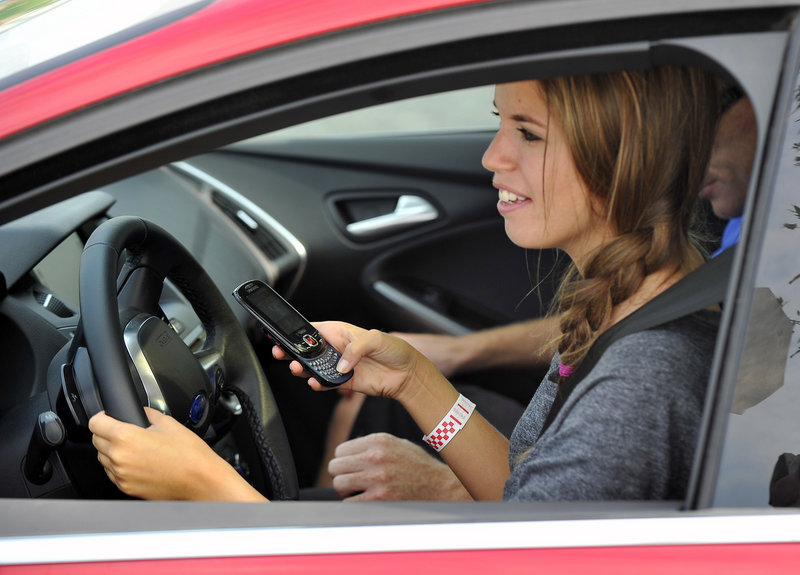SCARBOROUGH – Adam Cohen tried his hardest to drive at a steady speed and negotiate a driving course while sending a text message on an iPhone.
Even though he knows that texting and driving is dangerous and soon will be illegal, he wanted to show that he was the one who could beat the test.
“I think everybody learned today that you can’t,” said Cohen, sporting a Superman T-shirt.
Cohen, Scarborough High School’s senior class president, was one of 60 students who participated in the Ford Driving Skills for Life program Wednesday at the high school.
As Cohen jerked and swerved through the course in a Ford Focus, Mike Speck, the lead driving instructor, barked out “SEVEN, EIGHT, NINE,” counting the bright orange pylons the car had crumpled.
As the car came to a stop, Speck leaned into the driver’s side window and rated Cohen’s performance.
“How’d the text message come out?” he asked.
“Pretty good. We’re driving a ‘cat,’ not a ‘car,’” Cohen said, glancing at the phone.
Noting that Cohen’s speed was constant and his text was good, Speck said loudly, “You are a poster child for why not to do this.”
The drivers who are most focused on maintaining speed and texting accurately are the ones who hit the most cones, Speck said — and have the most crashes.
Distracted driving is a major issue as states wrestle with ways to keep drivers’ eyes on the road. A Maine law will take effect Sept. 28 to make it illegal to read or type a text message while driving.
Teenage drivers start at a disadvantage because of inexperience and a less developed sense of judgment. The U.S. Census, citing 2008 data, said teenage drivers represent 4.9 percent of the driving public but account for 12.3 percent of crashes and 8.6 percent of fatalities.
The most common causes are speed, inexperience and inattention, said Lauren Stewart, head of the Maine Bureau of Highway Safety, which helped arrange the Ford events in Maine.
The program, which will be at Bonny Eagle High School today, includes instruction, illustration and behind-the-wheel experience, delivered by professional race car drivers.
It has three components: impaired driving, distracted driving and learning to handle a slide.
The most exhilarating — for drivers and spectators — was a specially equipped Ford Mustang that helped students learn how to react when a car’s rear end loses traction during a turn.
The Mustang has a wheel assembly in the center of its back end that is lowered as the car turns, reducing the friction between the rear tires and the road. The loss of friction sends the car’s back end spinning.
“In racing, we refer to it as the car being ‘loose’ or being ‘free,’” Speck told a group of young drivers. “The No. 1 skill to have is simply to look at where you want the car to go. Your hands and feet become slaves to your eyes. If you look at me, you will drive right into me.”
Breanna Goode said the sensation of losing control of the car was momentarily terrifying.
“You know it’s going to happen, but still, in your mind, everything went blank for a second, and then you have to calm yourself down,” she said.
Meanwhile, Hailee Flaherty and Carly McLellan took turns driving a “Droid” green Ford Fiesta wearing “Fatal Vision” goggles.
The goggles warp the driver’s vision to simulate what it’s like to drive with a blood alcohol content of 0.12 percent to 0.15 percent, well over the legal limit for an adult. Teenage drivers who are caught with any alcohol in their blood will lose their license for a year, or for 18 months if they refuse the sobriety test.
“There was a curve, you went straight, you hit a tree,” Scarborough police Officer Frank Plourd told Flaherty after the imaginary tree, represented by a rubber cone, bumped against the car’s undercarriage.
Another cone is crumpled: “You killed a puppy,” said Plourd.
Scarborough Police Chief Robert Moulton said young people seem to be in agreement that drinking and driving is bad and seat belt use is automatic, but the distraction of cellphones remains a challenge.
“Kids tend to think they are invincible,” he said. “They can walk and text, and they assume they can drive and text.”
Staff Writer David Hench can be contacted at 791-6327 or at:
dhench@pressherald.com
Send questions/comments to the editors.



Success. Please wait for the page to reload. If the page does not reload within 5 seconds, please refresh the page.
Enter your email and password to access comments.
Hi, to comment on stories you must . This profile is in addition to your subscription and website login.
Already have a commenting profile? .
Invalid username/password.
Please check your email to confirm and complete your registration.
Only subscribers are eligible to post comments. Please subscribe or login first for digital access. Here’s why.
Use the form below to reset your password. When you've submitted your account email, we will send an email with a reset code.